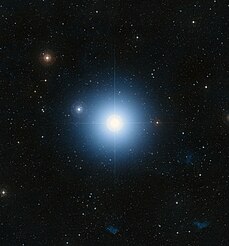LP 876-10
Discovery and observation

Fomalhaut C was catalogued as a high-proper-motion star by Willem Luyten in 1979, and later, in October 2013, was determined to be part of the Fomalhaut system. The star has a mass of 0.2 M☉, while Fomalhaut A is 1.9 M☉, and Fomalhaut B is 0.7 M☉. The apparent magnitude of Fomalhaut C is 12.6 requiring a six-inch aperture or larger telescope for direct visual observation. The entire system of Fomalhaut is around 440 million years old, which is roughly a tenth of the Solar System's age.
Debris disk
| Companion (in order from star) |
Mass | Semimajor axis (AU) |
Orbital period (days) |
Eccentricity | Inclination | Radius |
|---|---|---|---|---|---|---|
| Debris disk | 26.4±0.6 AU | 44±3° | — | |||
In December 2013, a debris disk was discovered around this star. This is the second debris disk in the system, as a first one was discovered around Fomalhaut A. The debris disc was discovered with the Herschel Space Telescope, and with the telescope the debris disc's temperature has been estimated at 24 K. The distance from the star was originally thought to be around 10 AU, but since it is hypothesized that it is mainly small grains, which trap more heat, it may be further. However, if it were beyond 40 AU, it would have been already cataloged, which gives it a radius between 10 and 40 AU.
The disk was directly detected by ALMA in 2021 and by JWST in 2024.
Comets
In addition to the debris disk, there are also comets orbiting Fomalhaut C. The debris disk orbiting C is sometimes referred to as a comet belt, due to some very elliptical orbits. The disk around Fomalhaut A is also thought to have many comets, as it is also elliptical. The Fomalhaut A belt is thought to possibly be due to a close encounter with either an undiscovered exoplanet, Fomalhaut B, or Fomalhaut C. With both A and C having comet belts, the absence of one around B is a mystery. Not only does the presence of comets make the belt more elliptical, it also makes it brighter which takes a part in its discovery.
It has been hypothesized that Fomalhaut C could have hidden exoplanets within its belt of comets and asteroids. It has also been hypothesized that A & C have interacted which could have formed C's comet belt if the interaction involved A giving up comets and debris. With Fomalhaut B not having any discs or belts around it, it could have been unaffected by the encounter between them.
Orbit
The orbit of Fomalhaut C around A is estimated to take 20 million years to complete. Due to the age of the three stars being 440 million years, and the distance of 2.5 light-years, this would mean that Fomalhaut C has only completed a full orbit around Fomalhaut A 22 times. The tidal radius of the Fomalhaut system is 6.2 light-years (1.9 parsecs), which makes Fomalhaut C well within it, which further proves the Fomalhaut system as trinary.
See also
- Fomalhaut
- TW Piscis Austrini (Fomalhaut B)
- Fomalhaut b
Notes
- ^ Radius calculated with temperature and luminosity
References
- ^ Matrà, L.; Marino, S.; Wilner, D. J.; Kennedy, G. M.; Booth, M.; Krivov, A. V.; Williams, J. P.; Hughes, A. M.; Burgo, C. del (2025-01-15). "REsolved ALMA and SMA Observations of Nearby Stars (REASONS): A population of 74 resolved planetesimal belts at millimetre wavelengths". arXiv:2501.09058 [astro-ph].
- ^ Vallenari, A.; et al. (Gaia collaboration) (2023). "Gaia Data Release 3. Summary of the content and survey properties". Astronomy and Astrophysics. 674: A1. arXiv:2208.00211. Bibcode:2023A&A...674A...1G. doi:10.1051/0004-6361/202243940. S2CID 244398875. Gaia DR3 record for this source at VizieR.
- ^ Zacharias, N. (2012). "The fourth US Naval Observatory CCD Astrograph Catalog (UCAC4)". VizieR On-line Data Catalog. Bibcode:2012yCat.1322....0Z.
- ^ Mamajek, Eric E.; et al. (2013). "The Solar Neighborhood. XXX. Fomalhaut C". The Astronomical Journal. 146 (6): 154–163. arXiv:1310.0764. Bibcode:2013AJ....146..154M. doi:10.1088/0004-6256/146/6/154. S2CID 67821813.
- ^ "Fomalhaut: Actually Triple Star, Astronomers Say | Astronomy". Sci-News.com. 2013-10-04. Retrieved 2016-01-17.
- ^ Cronin-Coltsmann, Patrick F.; Kennedy, Grant M.; et al. (July 2021). "ALMA imaging of the M-dwarf Fomalhaut C's debris disc". Monthly Notices of the Royal Astronomical Society. 504 (3): 4497–4510. arXiv:2104.13396. Bibcode:2021MNRAS.504.4497C. doi:10.1093/mnras/stab1237.
- ^ Kennedy, Grant M.; et al. (2013-12-17). "Discovery of the Fomalhaut C debris disc". Monthly Notices of the Royal Astronomical Society. 438 (1): L96 – L100. arXiv:1312.5315. Bibcode:2014MNRAS.438L..96K. doi:10.1093/mnrasl/slt168. S2CID 53600511.
- ^ "Fomalhaut's Little Sibling Has a Debris Disk Too". Astrobites.org. 2013-12-31. Retrieved 2016-01-17.
- ^ Hall, Shannon (2014-01-21). "Surprise! Fomalhaut's Kid Sister Has a Debris Disk Too". Universe Today. Retrieved 2016-01-17.
- ^ Lawson, Kellen; Schlieder, Joshua E.; et al. (May 2024). "JWST/NIRCam Detection of the Fomalhaut C Debris Disk in Scattered Light". The Astrophysical Journal. 967 (1): L8. arXiv:2405.00573. Bibcode:2024ApJ...967L...8L. doi:10.3847/2041-8213/ad4496.
- ^ "Companion's comets the key to curious exoplanet system?". Ras.org.uk. Retrieved 2016-01-17.
- ^ "Herschel Discovers a Comet Belt around Fomalhaut C". SciTech Daily. 2013-12-18. Retrieved 2016-01-15.
- ^ "Second Asteroid Ring Found In Three-Star Planetary System". Headlines & Global News. 2013-12-28. Retrieved 2016-01-15.
- ^ "Fomalhaut's Stellar Sister's Comets: Exoplanet Goldmine? : Discovery News". News.discovery.com. 2013-12-18. Archived from the original on 2016-03-11. Retrieved 2016-01-17.
- ^ Paul Gilster. "Cometary Clues to the Fomalhaut System?". Centauri-dreams.org. Retrieved 2016-01-17.
- ^ "ScienceShot: A 20-Million-Year Orbit". Science | AAAS. Aaas.org. 2013-10-03. Retrieved 2016-01-15.
- ^ "The existence of a third star in the Fomalhaut system - Spacefan.org". Spacefan.org. Archived from the original on 2014-05-15. Retrieved 2016-01-15.
